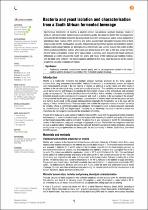 ResearchSpace
ResearchSpace
Bacteria and yeast isolation and characterisation from a South African fermented beverage
JavaScript is disabled for your browser. Some features of this site may not work without it.
- ResearchSpace
- →
- Research Publications/Outputs
- →
- Journal Articles
- →
- View Item
| dc.contributor.author |
Moodley, Sanchia S

|
|
| dc.contributor.author |
Dlamini, Nomusa R

|
|
| dc.contributor.author |
Steenkamp, Lucia H

|
|
| dc.contributor.author |
Buys, Elna M

|
|
| dc.date.accessioned | 2020-08-19T11:59:59Z | |
| dc.date.available | 2020-08-19T11:59:59Z | |
| dc.date.issued | 2019-11 | |
| dc.identifier.citation | Moodley, S.S., Dlamini, N.R., Steenkamp, L. & Buys, E.M. 2019. Bacteria and yeast isolation and characterisation from a South African fermented beverage. South African Journal of Science 115(11/12), pp. 1-6 | en_US |
| dc.identifier.issn | 0038-2353 | |
| dc.identifier.issn | 1996-7489 | |
| dc.identifier.uri | https://www.sajs.co.za/issue/view/722 | |
| dc.identifier.uri | https://www.sajs.co.za/article/view/5996 | |
| dc.identifier.uri | DOI: https://doi.org/10.17159/sajs.2019/5996 | |
| dc.identifier.uri | http://hdl.handle.net/10204/11543 | |
| dc.description | Copyright: 2019, Academy of Science of South Africa | en_US |
| dc.description.abstract | Spontaneous fermentation of motoho, a southern African non-alcoholic sorghum beverage, results in products with inconsistent microbiological and sensory quality. We aimed to identify the microorganisms involved in the fermentation of motoho by using culture-dependent techniques as well as culture-independent polymerase chain reaction (PCR) screening and matrix-assisted laser desorption/ionisation time-of-flight analysis (MALDI-TOF). Lactobacillus, Candida, Rhodotorula and Geotrichum species were identified. Sodium dodecyl sulfate polyacrylamide gel electrophoresis (SDS-PAGE) was used to evaluate the protein profiles of the isolated Lactobacillus species which produced protein bands of 14 kDa to 160 kDa, similar to those of other lactic acid bacteria isolated from various foods. A sensory panel evaluated and found significant differences (p<0.05) between the mouth feel, aroma and flavour of the traditional and modified motoho, with the latter being preferred. The microorganisms identified in this study could be used as starter cultures to optimise upscaled production of motoho. | en_US |
| dc.language.iso | en | en_US |
| dc.publisher | Academy of Science of South Africa | en_US |
| dc.relation.ispartofseries | Workflow;23325 | |
| dc.subject | Motoho | en_US |
| dc.subject | Food sciences | en_US |
| dc.subject | Food technologies | en_US |
| dc.title | Bacteria and yeast isolation and characterisation from a South African fermented beverage | en_US |
| dc.type | Article | en_US |
| dc.identifier.apacitation | Moodley, S. S., Dlamini, N. R., Steenkamp, L., & Buys, E. M. (2019). Bacteria and yeast isolation and characterisation from a South African fermented beverage. http://hdl.handle.net/10204/11543 | en_ZA |
| dc.identifier.chicagocitation | Moodley, Sanchia S, Nomusa R Dlamini, Lucia Steenkamp, and Elna M Buys "Bacteria and yeast isolation and characterisation from a South African fermented beverage." (2019) http://hdl.handle.net/10204/11543 | en_ZA |
| dc.identifier.vancouvercitation | Moodley SS, Dlamini NR, Steenkamp L, Buys EM. Bacteria and yeast isolation and characterisation from a South African fermented beverage. 2019; http://hdl.handle.net/10204/11543. | en_ZA |
| dc.identifier.ris | TY - Article AU - Moodley, Sanchia S AU - Dlamini, Nomusa R AU - Steenkamp, Lucia AU - Buys, Elna M AB - Spontaneous fermentation of motoho, a southern African non-alcoholic sorghum beverage, results in products with inconsistent microbiological and sensory quality. We aimed to identify the microorganisms involved in the fermentation of motoho by using culture-dependent techniques as well as culture-independent polymerase chain reaction (PCR) screening and matrix-assisted laser desorption/ionisation time-of-flight analysis (MALDI-TOF). Lactobacillus, Candida, Rhodotorula and Geotrichum species were identified. Sodium dodecyl sulfate polyacrylamide gel electrophoresis (SDS-PAGE) was used to evaluate the protein profiles of the isolated Lactobacillus species which produced protein bands of 14 kDa to 160 kDa, similar to those of other lactic acid bacteria isolated from various foods. A sensory panel evaluated and found significant differences (p<0.05) between the mouth feel, aroma and flavour of the traditional and modified motoho, with the latter being preferred. The microorganisms identified in this study could be used as starter cultures to optimise upscaled production of motoho. DA - 2019-11 DB - ResearchSpace DP - CSIR KW - Motoho KW - Food sciences KW - Food technologies LK - https://researchspace.csir.co.za PY - 2019 SM - 0038-2353 SM - 1996-7489 T1 - Bacteria and yeast isolation and characterisation from a South African fermented beverage TI - Bacteria and yeast isolation and characterisation from a South African fermented beverage UR - http://hdl.handle.net/10204/11543 ER - | en_ZA |





